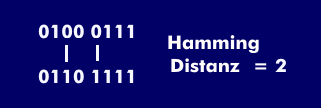hamming distance
The Hamming distance or the Hamming distance shows the difference between two binary words. The Hamming distance is a measure of the number of different binary characters located at the same position of the binary words.
If two binary words of the same length are compared, then according to DIN 44300 the number of bits in which the two differ is the Hamming distance or the Hamming distance. It is therefore a measure of the difference in which the two binary words differ.
The Hamming distance is used for error detection and error correction by comparing data units received over the transmission link with valid characters. A possible correction of the characters is done according to the probability principle. Whether error detection or error correction can be performed depends on the Hamming distance.
ing distance As an example the two bytes 0100 0111 and 0110 1111 are given. They have a Hamming distance of 2. This results from the fact that in the first halfbyte the third digit is a 0 in the first byte and a 1 in the second byte. Furthermore, the first digit in the second half byte is first a 0 and a 1 in the second byte. Such a distance can be used for error detection of all 1-bit errors, but not for their error correction. In contrast, a Hamming distance of 3 can be used to correct all 1-bit errors. This means that the ability of the codes to correct errors depends on the Hamming distance.The procedure can also be applied to decimal numbers or applied to words. For example, the two numbers 234567 and 224867 have a Hamming distance of 2 and the two words "hops" and "rye" have one of 3.
The Hamming distance is named after the mathematician Richard Wesley Hamming (1915 to 1998).

